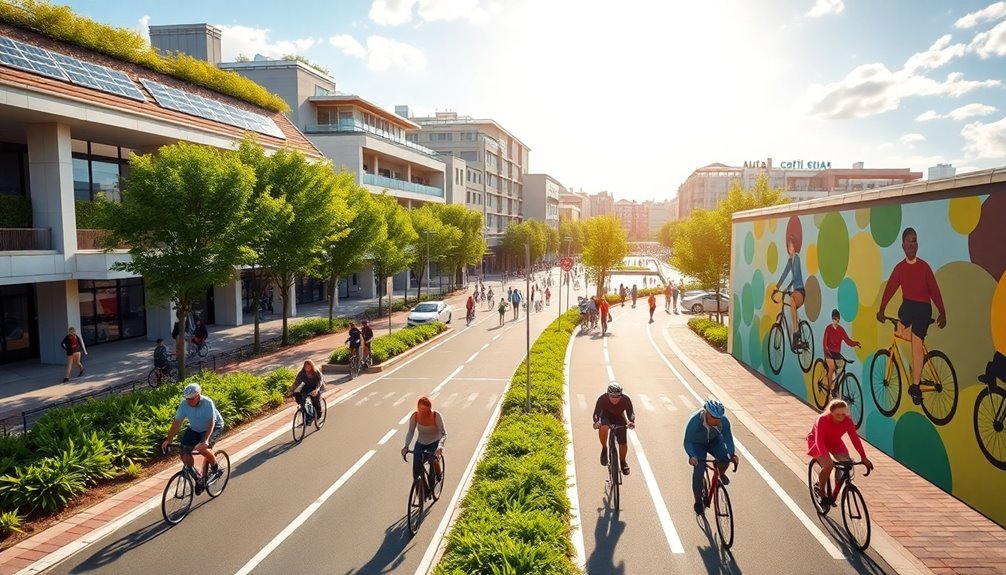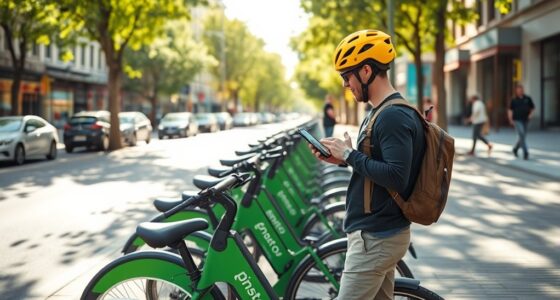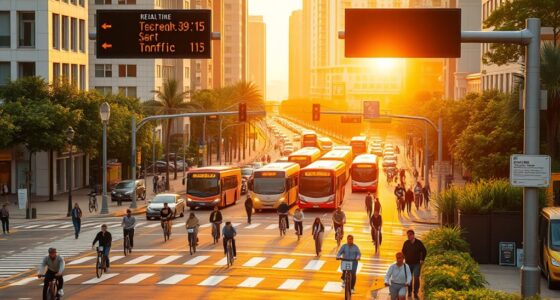Urban planning is reshaping the future of cycling by creating dedicated infrastructure that promotes safety and encourages more people to ride. Features like separated bike lanes, smart technology for e-bikes, and integrated public transport systems make cycling more accessible and convenient. This transition not only boosts public health and reduces emissions but also fosters economic benefits. As cities evolve, there's so much more to discover about these exciting changes and their impact on our urban environments.
Key Takeaways
- Urban planning integrates cycling infrastructure, enhancing connectivity and making cycling a viable transportation option for residents.
- Designing safe and accessible cycling pathways encourages more people to choose cycling over cars, reducing traffic congestion and emissions.
- Smart technology and data-driven maintenance improve cycling infrastructure reliability, promoting increased usage and safety for cyclists.
- Integrating cycling with public transportation systems simplifies travel, encouraging a shift towards sustainable transport modes and reducing car dependency.
- Community engagement in urban planning fosters inclusive cycling environments, addressing safety concerns and ensuring the needs of diverse populations are met.
The Role of Cycling Infrastructure in Sustainable Urban Development

As cities grow and evolve, investing in cycling infrastructure becomes essential for sustainable urban development. By promoting active transportation, you can help reduce traffic congestion and improve air quality.
Well-designed pathways and bike-friendly streets enhance urban livability, making it easier for you to integrate cycling with public transit. This investment not only encourages a healthier lifestyle but also offers economic benefits, such as lower health expenditures and reduced congestion costs.
Moreover, cycling infrastructure supports environmental goals by decreasing carbon emissions and fostering social inclusion, providing accessible transportation for diverse populations.
Ultimately, prioritizing cycling in urban planning leads to more livable, connected, and sustainable communities where you can thrive.
Innovative Trends Transforming Urban Cycling
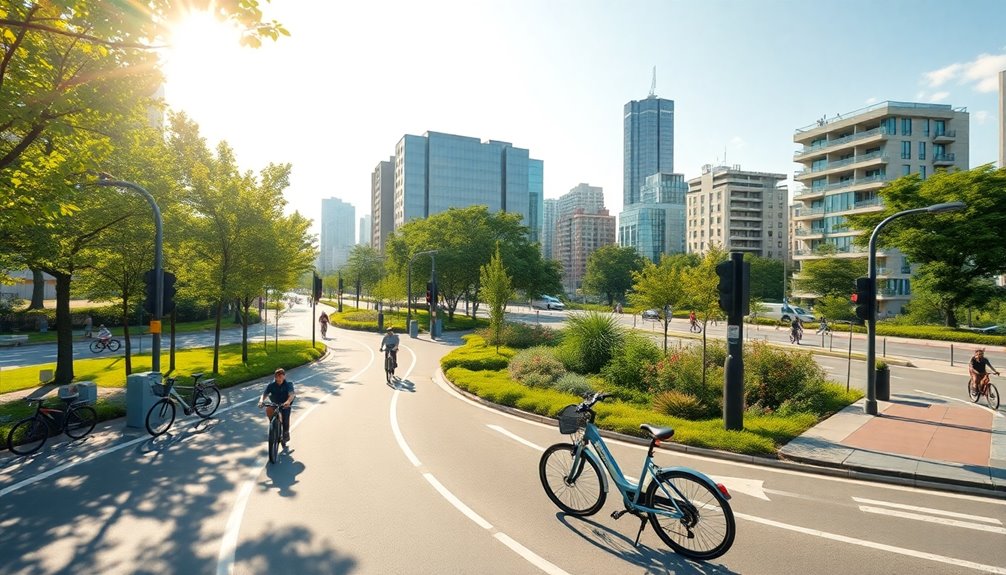
With cycling infrastructure firmly established as a cornerstone of sustainable urban development, innovative trends are now reshaping how you experience urban cycling.
Smart technology is revolutionizing e-bikes with features like GPS tracking and anti-theft mechanisms, enhancing both safety and convenience. E-bikes are also communicating with nearby vehicles, improving safety in crowded areas.
Smart technology is enhancing e-bikes with GPS tracking and anti-theft features, ensuring safety and convenience in urban cycling.
Battery advancements make e-bikes more efficient, while customizable designs cater to a wider range of cyclists.
Intelligent bike-sharing systems utilize real-time data to optimize availability, ensuring you always find a bike when needed.
Additionally, communities benefit from data-driven maintenance, making cycling infrastructure more reliable.
Embracing these trends, your urban cycling experience will be safer, more enjoyable, and increasingly accessible.
Designing Safe and Accessible Cycling Pathways

Designing safe and accessible cycling pathways is essential for encouraging more people to embrace cycling as a viable mode of transportation.
To create these pathways, you need to ensure they meet safety standards and are separated from traffic, especially on high-speed roads. Lowering speed limits through design changes can significantly reduce injuries. Incorporating buffer zones and clear signage helps keep cyclists safe and informed.
Aim for at least 2.2-meter-wide bike lanes to allow comfortable riding side-by-side. Additionally, consider accessibility features like curb cuts and ramps to accommodate all users.
Engaging with the community in planning ensures the pathways meet local needs, ultimately fostering a more inclusive cycling environment for everyone.
Integrating Cycling With Public Transportation Systems
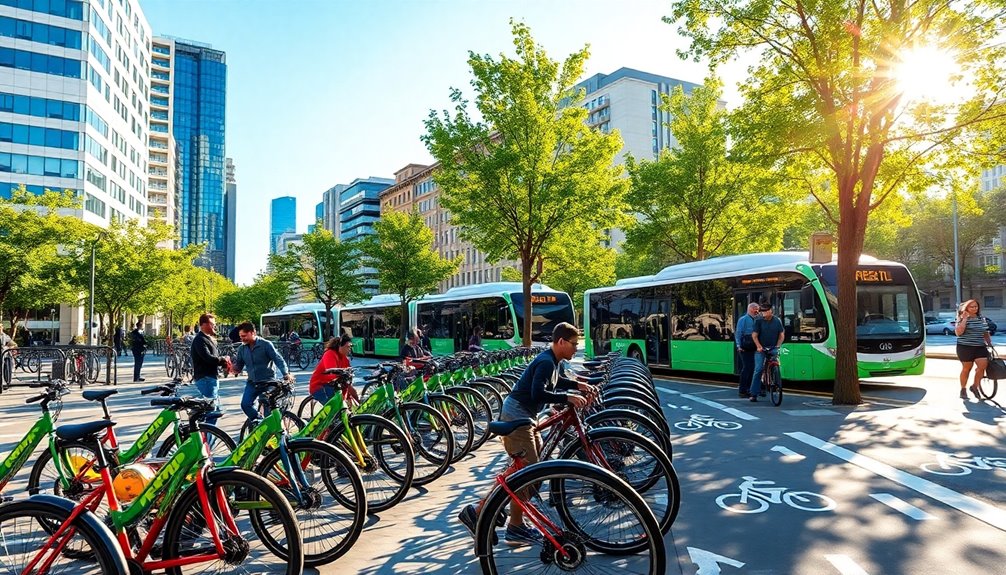
Integrating cycling with public transportation systems can significantly enhance urban mobility and promote sustainable travel. By combining these modes, you gain more mobility options, making those first and last miles simpler to navigate.
Integrating cycling with public transport enhances urban mobility, simplifying first and last-mile navigation for sustainable travel.
This integration reduces your reliance on cars, lowering emissions and fostering healthier urban environments. Plus, it encourages physical activity, contributing to better public health.
To make this work, proper infrastructure is essential. You'll need adequate bike parking, dedicated lanes, and integrated ticketing systems.
Engaging stakeholders and communities in planning ensures solutions meet local needs. Embracing technology, like mobile apps and smart bike-sharing, can further ease connections.
Cities worldwide demonstrate that successful integration can boost economic development and expand transit reach, making your commute more efficient and enjoyable.
Overcoming Challenges in Urban Cycling Adoption
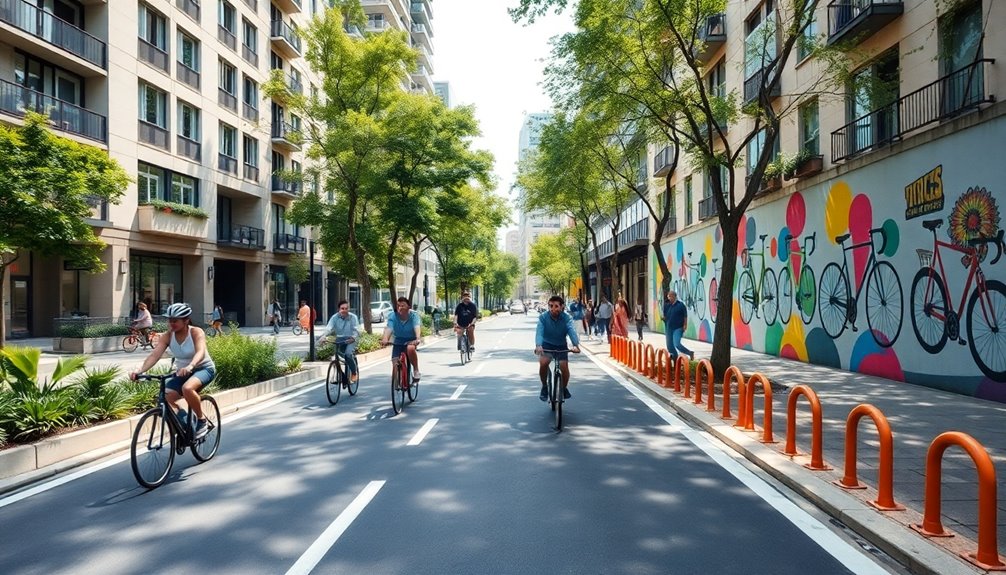
While many urban areas are recognizing the benefits of cycling, significant challenges still hinder widespread adoption.
You may find that a lack of protected bike lanes makes cycling feel unsafe, discouraging you from riding. Inadequate parking facilities can also be frustrating, as finding a secure place to leave your bike is essential.
Continuous cycling routes are necessary to promote cycling as a viable transport option, and high traffic volumes can be intimidating. Safety concerns, like traffic risks and personal security issues, further deter potential cyclists.
To overcome these hurdles, cities need to implement protected lanes, lower speed limits, and involve communities in planning.
The Public Health Benefits of Increased Cycling

Cities that overcome challenges in urban cycling can unlock numerous public health benefits.
When you cycle regularly, you significantly reduce your risk of chronic diseases like heart disease and diabetes, while also lowering all-cause mortality rates. You'll enjoy improved mental health, with less reliance on prescriptions and reduced stress levels.
Cycling acts as a moderate physical activity, enhancing your overall fitness and helping maintain a healthy heart. Moreover, studies show cyclists face lower cancer risks and mortality rates.
By incorporating cycling into your routine, you not only foster a healthier lifestyle but also boost your immune function.
Incorporating cycling into your daily routine enhances your health and strengthens your immune system.
Ultimately, embracing cycling can lead to a happier, healthier you while contributing to the well-being of your community.
Global Models of Successful Cycling Infrastructure
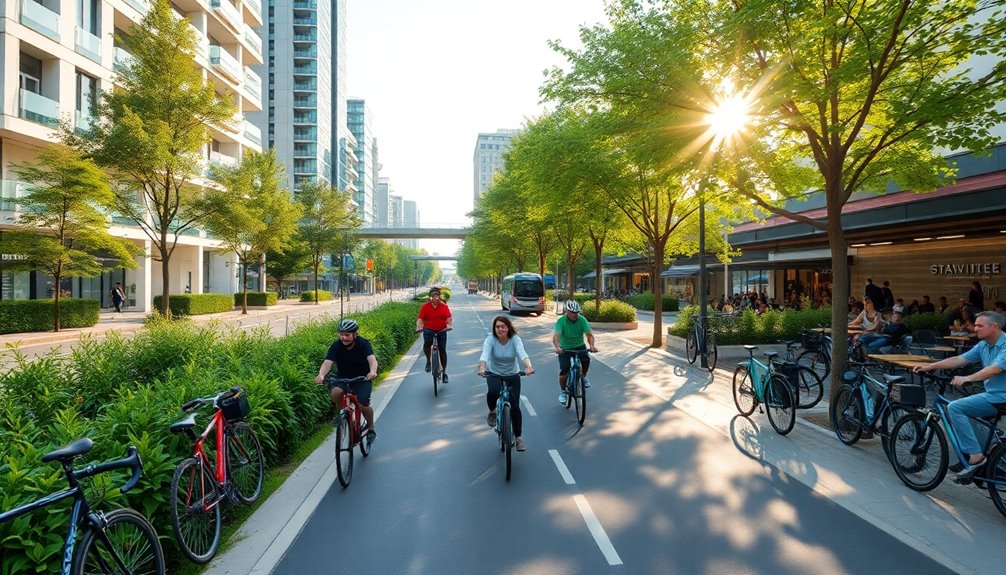
Successful cycling infrastructure serves as a vital backbone for urban mobility, fostering a healthier, more sustainable environment.
Cities like Bogota, Colombia, with over 550 kilometers of bike lanes, and Copenhagen, Denmark, renowned for dedicated paths, exemplify effective models.
In Seville, Spain, a 120-kilometer network has spurred a surge in cycling trips.
Amsterdam remains a global leader, promoting cycling as a primary transportation mode.
Antwerp, Belgium, integrates smart systems with 500 kilometers of pathways for safety and comfort.
Initiatives like EcoBici in Buenos Aires enhance accessibility, while the Cycles4Change Challenge in India encourages community-driven projects.
These examples highlight how thoughtful urban planning can create vibrant cycling cultures, making cities more livable and environmentally friendly.
The Future of Cycling in Urban Planning Initiatives

As urban planners look ahead, the integration of cycling into city infrastructure promises to reshape urban mobility significantly.
You'll see cities enhancing public transit by incorporating bike-share programs, making cycling a primary transport mode. Protected bike lanes near transit hubs will improve accessibility and safety for commuters, while expanded cycling networks connect seamlessly with public transport.
Community engagement is vital, ensuring that local voices shape the infrastructure. Planners will focus on equitable access and cultural sensitivity to meet diverse needs.
Safety measures, like traffic calming and dedicated lanes, will be prioritized to protect cyclists. Ultimately, these initiatives aim to reduce pollution, promote public health, and enhance overall urban livability, creating a sustainable and efficient transportation future.
Frequently Asked Questions
How Can Cycling Infrastructure Benefit Local Businesses?
Cycling infrastructure can significantly benefit local businesses by increasing foot traffic and making areas more accessible.
When you promote bike lanes, you attract more cyclists who tend to visit frequently and spend money.
Plus, bike parking is cost-effective, allowing for higher revenue per square meter than car spaces.
This creates a vibrant atmosphere, encourages customer loyalty, and can even draw wealthier cycling tourists, boosting the local economy and revitalizing the community.
What Role Do Community Organizations Play in Promoting Cycling?
Imagine a vibrant tapestry woven from bike wheels, where community organizations act as the threads connecting people.
These groups promote cycling by fostering social interactions, hosting events, and advocating for better infrastructure. They empower you through educational programs and encourage inclusivity, ensuring everyone can join the ride.
How Do Weather Conditions Affect Cycling Participation?
Weather conditions significantly influence your cycling participation.
When temperatures rise between 17°C and 33°C, you're more likely to hop on your bike. Conversely, rainy days can cut cycling volume in half, with just 8 mm of rain.
Wind and humidity also play a role; strong winds and high humidity can deter you from cycling.
Understanding these factors helps you plan better rides and enjoy more time on two wheels, regardless of the weather.
What Demographic Groups Are Most Likely to Cycle?
Picture a vibrant park filled with cyclists; you might notice that most of them are middle-aged, between 45 and 64 years old.
As you observe, you'll see men dominating the scene, making up 71% of riders.
You'll find a smaller group of younger cyclists, aged 25 to 34, while the elderly are rare.
Interestingly, individuals with higher education, particularly those holding bachelor's degrees, are more likely to hop on a bike and join the fun.
How Can Technology Improve Cycling Safety and Experience?
Technology can significantly improve your cycling safety and experience through innovations like smart helmets that detect crashes and alert emergency contacts.
Devices such as radar detection systems warn you of approaching vehicles, while airbag vests inflate to protect you during accidents.
LED light gloves enhance your visibility, and GPS-enabled helmet cameras help you document your rides.
With real-time tracking apps, you can share your location, ensuring added safety during solo adventures.
Conclusion
As urban planning evolves, it's clear that cycling is more than just a trend—it's a vital part of sustainable city living. By enhancing infrastructure and integrating cycling with public transport, we're not only making cities more accessible but also promoting healthier lifestyles. Remember, "where there's a will, there's a way." So let's embrace these innovations and support initiatives that make cycling a safe, enjoyable, and integral part of urban life for everyone.
